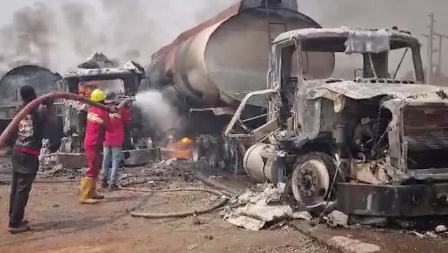While there are many factors affecting road safety in trucking that cause loss of life and extensive damage, not enough attention is paid to truck fires which present a great risk globally.
The United States has an estimated 7 000 truck fires annually.
According to the CEO of the South African-based MasterDrive, Eugene Herbert, most often, these fires are caused by fluid leaks, overheated brakes or wheel bearings, and damage to the exhaust system.
“Organisations lose revenue due to damaged goods and vehicles,” he pointed out, adding, “but most importantly are the lives of the drivers that these fires impact. With such high stakes on the line, it is essential that fleet operators upskill themselves and their drivers on high-risk scenarios and what to do to minimise this.”
Recently, at a truck fire simulation hosted by RNS Occupational Health and Safety in South Africa, attendees viewed a demonstration on truck fires and their effects on drivers and daily commuters. Bobby Shemmans, CEO of RNS Occupational Health and Safety, says: “It is important to note that these fires often start off small but end up becoming uncontrollable. Consequently, tankers, tyres and pallets of different materials, along with fire fighters to assist, were used to demonstrate how quickly it can happen and what course of action to follow.
“A fire needs three elements to sustain its growth: heat, air and a fuel source. As trucks often carry goods that are flammable, these vehicles are a breeding ground for flames as all three elements are present. This makes it very difficult to fight a fire without the proper equipment,” says Shemmans. Demonstrations also showed the additional fire risks. The round shape of a tyre makes it burn more easily. Yet, similar compounds can also be used in items such as pallets but without the round shape, it cannot retain heat and slows the spread of a fire. This illustrates that fire awareness includes using products that minimise the risk.
Other steps to reduce fire risk:
- The goal is to cool or extinguish a heat source as soon as it is identified.
- Proper vehicle maintenance and a safe system for drivers to follow is crucial.
- A driver should have a fire extinguisher compatible with the goods being transported.
- These should be checked regularly and kept easily accessible to drivers.
- Drivers should also be aware of emergency numbers should they encounter a fire.
- Train drivers on how to keep themselves and other motorists clear of any danger in case of a fire.
We encourage all to make meaningful steps towards educating their fleets on these risks.
“It is essential to understand and recognise the serious consequences of neglecting to undertake adequate training. Equipping drivers with the know-how on truck fire scan save their life and limit the loss the organisation faces as well,” says Herbert.
©Copyright MOTORING WORLD INTERNATIONAL. All rights reserved. Materials, photographs, illustrations and other digital content on this website, may not be reproduced, published, broadcast, rewritten or redistributed in whole or in part without prior written permission from Motoring World International
Contact: editor@motoringworldng.com





